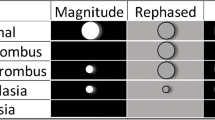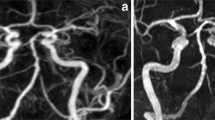Abstract
Recently, time-of-flight (TOF) and gadolinium-enhanced MR angiography (MRA) imaging have been used to demonstrate subacute intramural hematoma in cervical artery dissection and to detect intraplaque haemorrhage. Our aim was to perform an exploratory study to analyse if venous thrombus-related signal changes (potentially showing iso- or hyperintensity) in cerebral venous sinus thrombosis (CVST) could be observed on 3D-TOF MRA imaging. We analysed retrospectively MRIs of CVST patients in whom both contrast-enhanced MR venography (CEMRV) and 3D-TOF sequences were performed in the acute/subacute phase (i.e. < 31 days after symptom onset). The occluded sinus segments were defined on CEMRV. First, analyses of signal changes in occluded venous sinuses segments (defined by and unblinded to CEMRV) on native 3D-TOF images and morphological MRI sequences were performed. Second, a blinded (to CEMRV and other morphological MRI sequences) analysis was performed on 3D-TOF imaging assessing signal changes on 3D-TOF considering all sinus segments. Twenty-five CVST patients were included. 3D-TOF imaging showed signal changes (most often hyperintensity and less often isointensity) in 84% of the occluded sinus segments. Signal changes were observed in 91% of the occluded sinus segments on T1-weighted imaging, in 69% on T2-weighted imaging, in 68% on FLAIR, in 32% on DWI, and in 55% on T2*-weighted imaging. On blinded analysis, sensitivity of 3D-TOF sequences decreased to 80%, whereas specificity was only 65%. Abnormal signal in the venous sinuses on 3D-TOF may possibly help to suspect CVST, especially when CEMRV sequences lack.

Similar content being viewed by others
References
Bonneville F (2014) Imaging of cerebral venous thrombosis. Diagn Interv Imaging 95:1145–1150
Patel D, Machnowska M, Symons S, Yeung R, Fox AJ, Aviv RI et al (2016) Diagnostic performance of routine brain MRI sequences for dural venous sinus thrombosis. AJNR Am J Neuroradiol 37:2026–2032
Sadigh G, Mullins ME, Saindane AM (2016) Diagnostic performance of mri sequences for evaluation of dural venous sinus thrombosis. AJR Am J Roentgenol 206:1298–1306
Lövblad KO, Bassetti C, Schneider J, Guzman R, El-Koussy M, Remonda L et al (2001) Diffusion-weighted mr in cerebral venous thrombosis. Cerebrovasc Dis 11:169–176
Chu K, Kang DW, Yoon BW, Roh JK (2001) Diffusion-weighted magnetic resonance in cerebral venous thrombosis. Arch Neurol 58:1569–1576
Idbaih A, Boukobza M, Crassard I, Porcher R, Bousser MG, Chabriat H (2006) MRI of clot in cerebral venous thrombosis: high diagnostic value of susceptibility-weighted images. Stroke 37:991–995
Ihn YK, Jung WS, Hwang SS (2013) The value of T2*-weighted gradient-echo MRI for the diagnosis of cerebral venous sinus thrombosis. Clin Imaging 37:446–450
Bidar F, Faeghi F, Ghorbani A (2016) Assessment of cerebral venous sinus thrombosis using T2 (*)-weighted gradient echo magnetic resonance imaging sequences. Iran J Neurol 15:96–99
Habs M, Pfefferkorn T, Cyran CC, Grimm J, Rominger A, Hacker M et al (2011) Age determination of vessel wall hematoma in spontaneous cervical artery dissection: a multi-sequence 3T cardiovascular magnetic resonance study. J Cardiovasc Magn Reson 13:76
Kirsch E, Kaim A, Engelter S, Lyrer P, Stock KW, Bongartz G et al (1998) MR angiography in internal carotid artery dissection: improvement of diagnosis by selective demonstration of the intramural haematoma. Neuroradiology 40:704–709
Li Q, Wang J, Chen H, Gong X, Ma N, Gao K et al (2015) Characterization of craniocervical artery dissection by simultaneous MR noncontrast angiography and intraplaque hemorrhage imaging at 3T. AJNR Am J Neuroradiol 36:1769–1775
Qiao Y, Etesami M, Malhotra S, Astor BC, Virmani R, Kolodgie FD et al (2011) Identification of intraplaque hemorrhage on MR angiography images: a comparison of contrast-enhanced mask and time-of-flight techniques. AJNR Am J Neuroradiol 32:454–459
Yoshimura S, Yamada K, Kawasaki M, Asano T, Kanematsu M, Takamatsu M et al (2011) High-intensity signal on time-of-flight magnetic resonance angiography indicates carotid plaques at high risk for cerebral embolism during stenting. Stroke 42:3132–3137
Yamada K, Song Y, Hippe DS, Sun J, Dong L, Xu D et al (2012) Quantitative evaluation of high intensity signal on MIP images of carotid atherosclerotic plaques from routine TOF-MRA reveals elevated volumes of intraplaque hemorrhage and lipid rich necrotic core. J Cardiovasc Magn Reson 14:81
Author information
Authors and Affiliations
Corresponding author
Ethics declarations
Conflict of interest
None of the authors have conflicts of interest.
Ethical approval
All procedures performed in studies involving human participants were in accordance with the ethical standards of the institutional and/or national research committee and with the 1964 Helsinki Declaration and its later amendments or comparable ethical standards.
Informed consent
It was obtained from the study participants.
Rights and permissions
About this article
Cite this article
Renard, D., Le Bars, E., Arquizan, C. et al. Time-of-flight MR angiography in cerebral venous sinus thrombosis. Acta Neurol Belg 117, 837–840 (2017). https://doi.org/10.1007/s13760-017-0835-2
Received:
Accepted:
Published:
Issue Date:
DOI: https://doi.org/10.1007/s13760-017-0835-2




